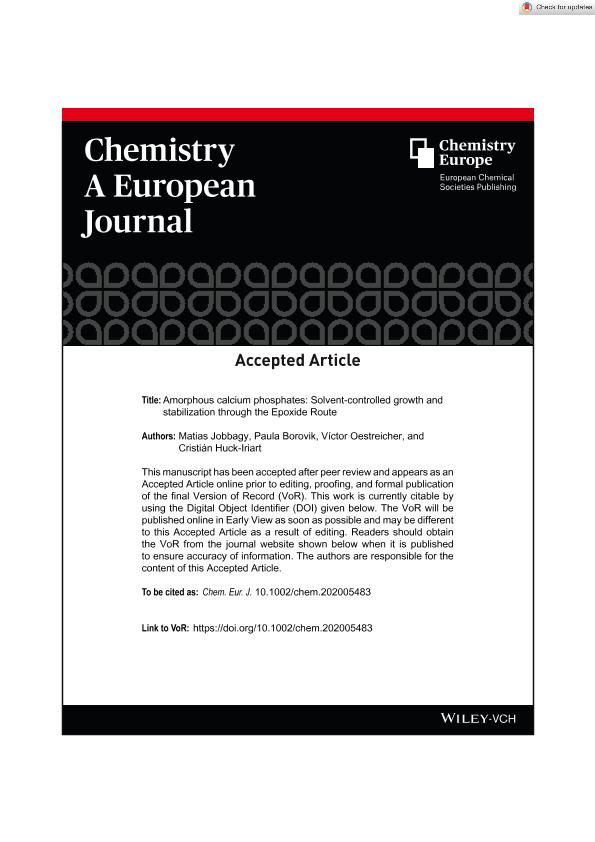Mostrar el registro sencillo del ítem
dc.contributor.author
Borovik, Paula Florencia

dc.contributor.author
Oestreicher, Víctor Santiago Jesús

dc.contributor.author
Huck Iriart, Cristián

dc.contributor.author
Jobbagy, Matias

dc.date.available
2022-04-08T17:50:23Z
dc.date.issued
2021-04-22
dc.identifier.citation
Borovik, Paula Florencia; Oestreicher, Víctor Santiago Jesús; Huck Iriart, Cristián; Jobbagy, Matias; Amorphous calcium phosphates: Solvent‐controlled growth and stabilization through the Epoxide Route; Wiley VCH Verlag; Chemistry- A European Journal; 27; 39; 22-4-2021; 10077–10086
dc.identifier.issn
0947-6539
dc.identifier.uri
http://hdl.handle.net/11336/154806
dc.description.abstract
Calcium phosphates stand among the most promising nanobiomaterials in key biomedical applications as bone repairment, signalling or drug/gene delivery. Intrinsic properties as crystalline structure, composition, particle shape and size define the successful use of these phases. Among them, metastable amorphous calcium phosphate (ACP) is currently gaining particular attention due to its inherently high reactivity in solution, which is crucial in bone development mechanisms. However, the preparation of this highly desired (bio)material with control over its shape, size and phase purity Calcium phosphates stand among the most promising nanobiomaterials in key biomedical applications as bone repairment, signalling or drug/gene delivery. Their intrinsic properties as crystalline structure, composition, particle shape and size define their successful use. Among these compounds, metastable amorphous calcium phosphate (ACP) is currently gaining particular attention due to its inherently high reactivity in solution, which is crucial in bone development mechanisms. However, the preparation of this highly desired (bio)material with control over its shape, size and phase purity remains as a synthetic challenge. Herein, we have adapted the Epoxide Route for the synthesis of pure and stable ACP colloids. By using biocompatible solvents such as ethylene glycol and/or glycerine we are able to avoid the natural tendency of ACP to maturate into more stable and crystalline apatites. Moreover, this procedure offers size control, ranging from small nanoparticles (60 nm) to micrometric spheroids (>500 nm). The eventual fractalization of the internal mesostructured can be tuned, by simply adjusting the composition of the ethylene glycol:glycerine solvent mixture. These findings introduce the use of green solvents as a new tool to control crystallinity and/or particle size in the synthesis of nanomaterials, avoiding the use of capping agents and preserving the natural chemical reactivity of the pristine surface. remains as a synthetic challenge. Herein, we have adapted the Epoxide Route for the synthesis of pure and stable ACP colloids. By using biocompatible solvents such as ethylene glycol and/or glycerine we are able to avoid the natural tendency of ACP to maturate into more stable and crystalline apatites. Moreover, this procedure offers size control, ranging from small nanoparticles (60 nm) to micrometric spheroids (>500 nm). The eventual fractalization of the internal mesostructured can be tuned, by simply adjusting the composition of the ethylene glycol:glycerine solvent mixture. These findings introduce the use of green solvents as a new tool to control crystallinity and/or particle size in the synthesis of nanomaterials, avoiding the use of capping agents and preserving the natural chemical reactivity of the pristine surface.
dc.format
application/pdf
dc.language.iso
eng
dc.publisher
Wiley VCH Verlag

dc.rights
info:eu-repo/semantics/openAccess
dc.rights.uri
https://creativecommons.org/licenses/by-nc-nd/2.5/ar/
dc.subject
CALCIUM PHOSPHATES
dc.subject
EPOXIDE ROUTE
dc.subject
AMORPHOUS
dc.subject
BIOMATERIALS
dc.subject.classification
Química Coloidal

dc.subject.classification
Ciencias Químicas

dc.subject.classification
CIENCIAS NATURALES Y EXACTAS

dc.title
Amorphous calcium phosphates: Solvent‐controlled growth and stabilization through the Epoxide Route
dc.type
info:eu-repo/semantics/article
dc.type
info:ar-repo/semantics/artículo
dc.type
info:eu-repo/semantics/publishedVersion
dc.date.updated
2022-04-07T20:52:51Z
dc.identifier.eissn
1521-3765
dc.journal.volume
27
dc.journal.number
39
dc.journal.pagination
10077–10086
dc.journal.pais
Alemania

dc.description.fil
Fil: Borovik, Paula Florencia. Consejo Nacional de Investigaciones Científicas y Técnicas. Oficina de Coordinación Administrativa Ciudad Universitaria. Instituto de Química, Física de los Materiales, Medioambiente y Energía. Universidad de Buenos Aires. Facultad de Ciencias Exactas y Naturales. Instituto de Química, Física de los Materiales, Medioambiente y Energía; Argentina. Comisión Nacional de Energía Atómica. Unidad Ejecutora Instituto de Nanociencia y Nanotecnología. - Consejo Nacional de Investigaciones Científicas y Técnicas. Oficina de Coordinación Administrativa Ciudad Universitaria. Unidad Ejecutora Instituto de Nanociencia y Nanotecnología; Argentina
dc.description.fil
Fil: Oestreicher, Víctor Santiago Jesús. Consejo Nacional de Investigaciones Científicas y Técnicas. Oficina de Coordinación Administrativa Ciudad Universitaria. Instituto de Química, Física de los Materiales, Medioambiente y Energía. Universidad de Buenos Aires. Facultad de Ciencias Exactas y Naturales. Instituto de Química, Física de los Materiales, Medioambiente y Energía; Argentina. Universidad de Valencia. Instituto de Ciencia Molecular.; España
dc.description.fil
Fil: Huck Iriart, Cristián. Universidad Nacional de San Martín. Escuela de Ciencia y Tecnología; Argentina. Consejo Nacional de Investigaciones Científicas y Técnicas; Argentina
dc.description.fil
Fil: Jobbagy, Matias. Consejo Nacional de Investigaciones Científicas y Técnicas. Oficina de Coordinación Administrativa Ciudad Universitaria. Instituto de Química, Física de los Materiales, Medioambiente y Energía. Universidad de Buenos Aires. Facultad de Ciencias Exactas y Naturales. Instituto de Química, Física de los Materiales, Medioambiente y Energía; Argentina. Universidad de Valencia. Instituto de Ciencia Molecular.; España
dc.journal.title
Chemistry- A European Journal

dc.relation.alternativeid
info:eu-repo/semantics/altIdentifier/url/https://onlinelibrary.wiley.com/doi/10.1002/chem.202005483
dc.relation.alternativeid
info:eu-repo/semantics/altIdentifier/doi/http://dx.doi.org/10.1002/chem.202005483
Archivos asociados
